
| 
|

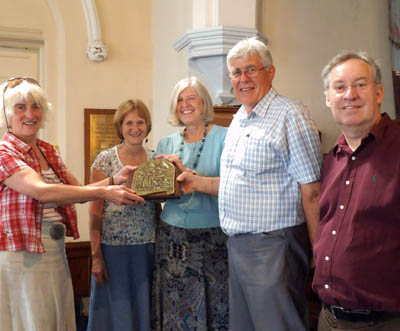 History of the Springs and Wells movement in the Malvern Hills, Part 4.
History of the Springs and Wells movement in the Malvern Hills, Part 4.PART FOUR - UNHINDERED PROGRESS
THE FOURTH SEPTENNIAL 2014 - 2021
by Dr Bruce E Osborne
Meanwhile, the Friends of Malvern Springs and Wells continued to go from strength to strength. Following the closure of Colwall Malvern Water bottling plant, the Stone Bottle Fountain was relocated to the Three Counties Showground as a tribute to the 160 years of bottling Schweppes Malvern Water. Here it was placed in a purpose built ornamental garden and unveiled by the Bishop of Worcester. Throughout, the bi-monthly Friends of Malvern Springs and Wells newsletter continued to promote the latest information on Malvern Springs and Wells.
In the summer of 2014 the Owls Hole pump and engine reappeared when taken over by local engine enthusiast John Clifford. It was first rescued in the 1990s. In 2014 this vintage well pump and power plant soon re-appeared at events at the Three Counties Showground, chugging away for several hours each day.
 Awards scheme and the Friends newsletters which often prompted major newspaper coverage.
Awards scheme and the Friends newsletters which often prompted major newspaper coverage.As 2015 drew to a close the Lodge Fountain restoration proceeded. This highlighted the problem of funding urgent restoration needs. In the case of the Lodge Fountain, the Civic Society had been approached for funding. Agreeing in principal they then sought to stipulate a number of totally inept conditions resulting in major delays in furthering the project. These were unacceptable and fortunately a private donor came to the rescue. What was perhaps needed was a continual fund to be maintained for such purposes. The question as to how to raise the monies however still awaited resolution in 2015.
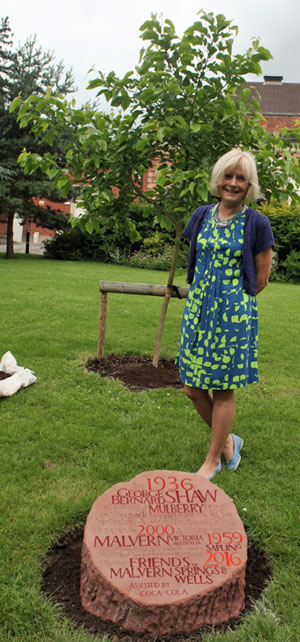 The new Mulberry
Tree together with a plaque in Priory Park, near the site of the original which
blew down in a storm in the year 2000, was unveiled by Di Foster from Malvern, Melbourne.
A series of associated events planned for the day ended with an evening of food
and general celebration at the Mount Pleasant Hotel. Di with the tree and plaque is pictured left.
The new Mulberry
Tree together with a plaque in Priory Park, near the site of the original which
blew down in a storm in the year 2000, was unveiled by Di Foster from Malvern, Melbourne.
A series of associated events planned for the day ended with an evening of food
and general celebration at the Mount Pleasant Hotel. Di with the tree and plaque is pictured left.
This event in the summer of 2016 also prompted interest in the many Malverns around the world and was the seed of the project that became known as Malverns Worldwide. The project was in due course to have significant ramifications across the globe.
Other events in 2016 included the findings of research into the demise of the West Malvern Spa building. This was apparently due to a structural defect that resulted in the beams supporting the floors and roof rotting. Also Marienbad in the Czech Republic aroused interest. Here the Singing Fountain was explored to see if such a creation had potential in Malvern, England. This trip coincided with the Malvern Civic Society twinning with Marienbad.
By October 2016 the Malverns Worldwide project was formulated and the tracking down and contact with Malverns across the globe ensued. This project aimed to extend the hand of friendship to all who were associated with the many Malverns world-wide. Their history invariably tracked back to Great Malvern in England where the Malvern religious establishment and community was created at the time of Edward the Confessor, just before the Norman Conquest. The story of the creation of the original Malvern was translated from the medieval stained glass windows in the Malvern Priory. Significantly a visit by envoys Cora and Bruce to Malvern, New York resulted in the establishment of 19th October as Malvern Appreciation Day; a celebration that has been continued ever since.

Early in 2017, Cora and Bruce celebrated their 25th anniversary of working on the springs and wells and more recently Malverns Worldwide. Over that time they had published extensively on the water sources of the Malvern Hills having researched and categorised over 130 sites of specific interest. Their latest investigation was the earlier gold mining on the Malvern Hills which had possible relevance to the development of Malvern, Johannesburg in South Africa, now a major gold producer.
The year 2017 saw other events that promoted Malverns including a visit to Malvern, Pennsylvania. Here a formal greeting by the mayor and the local senator cemented a relationship that was to perpetuate for many years. It was also pleasing to record that the Tank House in Colwall, once on the site of the Malvern Water bottling works, had survived as the central focus of a modern housing estate. The efforts at getting the building listed as a significant historic edifice had resulted in a forward plan that gave it prominence in a modern context. As the year progressed Barbados was welcomed into the Malverns Worldwide project with the Malvern House and plantation. The state flag of Malvern Pennsylvania was also flown from the Great Malvern Council Offices on the 19th October to celebrate Malvern Appreciation Day.
By May 2018 concern was once again increasing about the state of the springs and wells around the Malvern Hills. Each year Well Decorating was a very successful event early in May. In spite of this, deterioration and contamination of springs and water sources caused concern. Animal contamination was often the cause, especially after a dry period followed by rain when contaminated surface water entered the fountains and spouts. Public interest versus the health and safety issues needed a careful balance in dealing with this major unique resource for the Malvern Hills region.
Another significant event in 2018 was the securing of planning permission for the building of a Lodge within the Malvern Hills District Council area. This was intended to offer accommodation to overseas visitors coming to Malvern as part of the Malverns Worldwide scheme.
Following earlier contact with Malvern House and plantation in Barbados we received a request for a cutting for a George Bernard Shaw Mulberry Tree for planting. We were delighted to arrange for three cuttings from the Malvern, Melbourne tree to be duly delivered for rearing on the Caribbean Island. As part of the Malverns Worldwide project, in 2018 contact was made with Malverns along the historic Lincoln Highway in the United States. Malvern Iowa has since become an enthusiastic active member of the project. Mulberry Pie was also on the agenda and a recipe from Malvern Iowa resulted in pie parties in England to try out variations of the recipe.
Early in
March 2019, extensive building proposals and development around the Malvern
Hills resulted in concern for the long term environmental impact on the Malvern
Hills. In conjunction with High Street Malvern, a proposal was formulated and
published to establish the region at large as a National Park. Bruce's
experience in the 1990s at the University of Sussex with investigating the
implications of the possible South Downs National Park was invaluable in developing
a proposal. By promoting the concept of national park status it was seen as a
way of resolving many issues of major concern relating to the conservation of
the wider region around the Malvern Hills. The bi-monthly Friends Newsletter
was by now up to number 80 and proved a superb means of communicating with
everyone with an interest in Malverns and as a result gauging reactions to such
a proposal as a Malvern Hills National Park.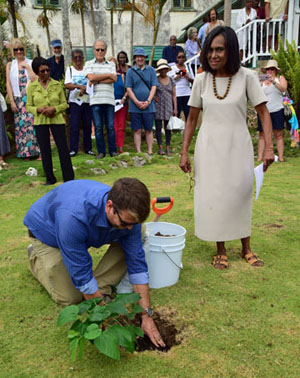
March 2019 also saw the formal planting of the George Bernard Shaw Mulberry Tree at Malvern Great House Barbados. In the picture June Cheesman who owns the house assists the Director of Barbados National Trust to formally plant the tree during an open day attended by over 300 visitors. Six formal proclamations and declarations were received from Malverns elsewhere congratulating June on the planting.
Shortly after the above we were astonished to learn that Donald Trump's uncle John Trump spent his war years in Great Malvern at the Defence Research Establishment. His nephew Donald was to progress to the role of President of the United States.
In the summer Cora also spent a lot of time investigating Mulberry Pie as part of our Mulberry Tree celebrations. Many strange purple mixes and recipes came under scrutiny and were eaten. The Mount Pleasant in Great Malvern even opened a Mulberry Restaurant. It was a year later that we were to learn that our trees in Great Malvern were white mulberries!
Following the visit to Malvern Iowa in October 2019 as part of the Malverns Worldwide project, Andrea Morgan, Chair of Malvern Hills District Council received two commemorative plates. Presented by Cora and Bruce, these were gifted to Great Malvern by the residents of Malvern Iowa and pictorially record the local history and the early Christian church. They now reside at the Malvern Council Offices, England in a cabinet that contains a number of souvenir gifts exchanged between Malverns across the globe and Great Malvern.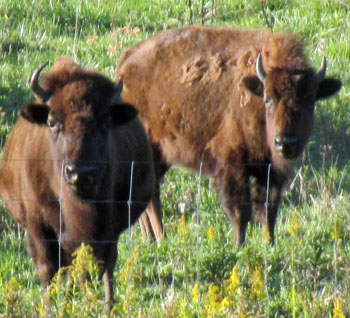
Malvern Appreciation Day 19th October saw our envoys visit Malvern, Toronto, Canada. This took our contact and the Malverns Worldwide scheme to yet another country.
By the end of 2019 we had Malverns Worldwide membership extended to Malvern Ohio. The main State Route 43 highway runs alongside the river and what was once the canal bed, and this links Malvern to the rest of the world. When exploring the immediate surroundings of the town we came across a herd of Buffalo. These curious creatures will probably come to greet you if they catch sight of you on their territory. Beware, they are big when up close!
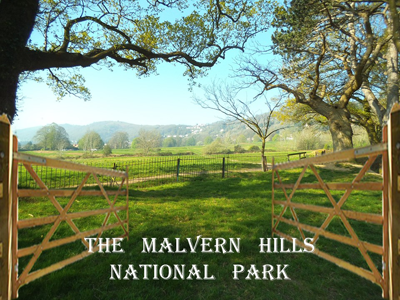 At a time when we are all concerned about environmental issues, urbanisation and conservation of the countryside, should we now reconsider the original status of the Malvern Hills to ascertain whether true National Park status should be applied to advantage? A series of presentations and lectures announced our thoughts at the end of 2019 and early 2020. In addition, we mounted a web page for both the National Park proposals and the linked Gateway Towns proposals. These had been evolving since 1991 when the University of Birmingham orchestrated a study on Malvern Tourism.
At a time when we are all concerned about environmental issues, urbanisation and conservation of the countryside, should we now reconsider the original status of the Malvern Hills to ascertain whether true National Park status should be applied to advantage? A series of presentations and lectures announced our thoughts at the end of 2019 and early 2020. In addition, we mounted a web page for both the National Park proposals and the linked Gateway Towns proposals. These had been evolving since 1991 when the University of Birmingham orchestrated a study on Malvern Tourism.
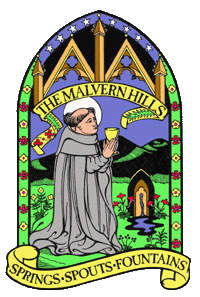 A second area of evolving interest was the creation of Malvern during the 11th century and the relationship of St Werstan to this. Although the provenance of Werstan is confusing due to many earlier misinterpretations of his history; investigations carried out for The Illumination of St Werstan the Martyr, (2006) by Osborne and Weaver resulted in a clearer understanding. The focus of this research was the medieval stained-glass windows in Malvern Priory, whose order had been muddled over the centuries. Using the windows and other supporting evidence, the study concluded the credible history of Werstan and his first establishment of a Malvern religious cell circa 1055. However, a visit to the Bayeux Tapestry in the latter part of 2019 had thrown light on what happened after St Werstan's murder. The Norman Conquest took place and William Fitz Osbern was delegated with the task of completing the Norman conquest in the south and west. This was completed satisfactorily by 1071. One outcome was the re-establishment of the religious centre in Great Malvern and the eventual building of the Priory that we know today.
A second area of evolving interest was the creation of Malvern during the 11th century and the relationship of St Werstan to this. Although the provenance of Werstan is confusing due to many earlier misinterpretations of his history; investigations carried out for The Illumination of St Werstan the Martyr, (2006) by Osborne and Weaver resulted in a clearer understanding. The focus of this research was the medieval stained-glass windows in Malvern Priory, whose order had been muddled over the centuries. Using the windows and other supporting evidence, the study concluded the credible history of Werstan and his first establishment of a Malvern religious cell circa 1055. However, a visit to the Bayeux Tapestry in the latter part of 2019 had thrown light on what happened after St Werstan's murder. The Norman Conquest took place and William Fitz Osbern was delegated with the task of completing the Norman conquest in the south and west. This was completed satisfactorily by 1071. One outcome was the re-establishment of the religious centre in Great Malvern and the eventual building of the Priory that we know today.
The Foley Fountain at The Mount Pleasant Hotel in Great Malvern has continued with its plan to protect the historic Foley Fountain from further weather damage by building a shelter over it. Having built the protective roof, last year someone caused major damage to the fountain, probably by sitting on the basin for a smoke under the new shelter. We can now report that the shelter has been finished and the broken basin restored with a Malvern stone plinth built beneath it. Now further effort in 2020 is going into restoring the fountain head spout.
One major problem that harassed but also provided opportunity, was the corona pandemic that really swung into action in March with a national lockdown. It severely disrupted person to person interaction in many contexts but also gave individuals time to pursue particular interests. As a result we launched a new format newsletter which initially exchanged experiences with Malverns across the globe. This was followed by a Malverns Worldwide Facebook site encouraging interaction on-line.
.
Website: Click Here
SUPPLEMENTARY INFORMATION
1) TOPOGRAPHICAL LOCATION:
Malvern Hills - arguably Britain's original National Park
3) INFORMATION CATEGORY:
Springs and Wells General InterestHistory & Heritage


